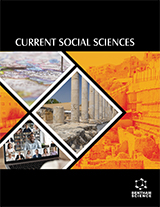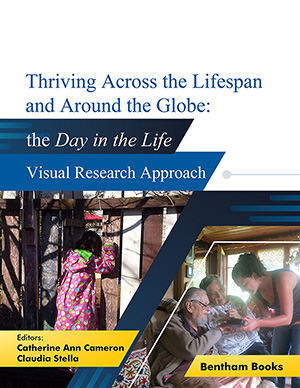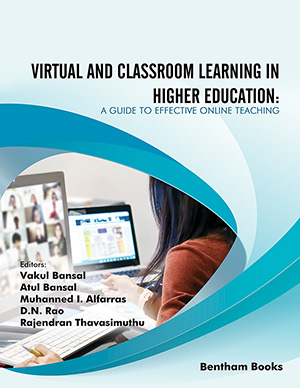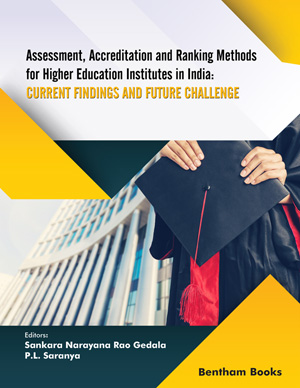Preface
Page: i-i (1)
Author: Satya Prakash Yadav, Sansar Singh Chauhan, Sanjeev Kumar Pippal and Victor Hugo C. de Albuquerque
DOI: 10.2174/9789815136173123010001
Investigating the Features of Physical Layer Structure for Employment of Smart City Models
Page: 1-13 (13)
Author: Rishabh Jain*, Srishti Jain, Muskan Jindal and Mahaveer Singh Naruka
DOI: 10.2174/9789815136173123010003
PDF Price: $15
Abstract
In today’s world, when everything around us is getting smart, be it the
“phone” or “television”, there is an utter need and high time for the cities to get smart
to solve the major problems of mankind. It is a futuristic approach to alleviate obstacles
caused due to day by day increasing population of India. It will help the government as
well as the common people to fight daily life problems such as water scarcity, waste
management, and lack of interconnectivity in a city that can cause serious problems
like delayed responses to emergency situations. This paper mainly focuses on the
salient features of the smart city “Dholera” in Gujarat, India. The city uses futuristic
technologies like Artificial Intelligence (AI) and the Internet of Things(IoT) to
automate city resources. It has AI-based smart grids, transportation, water and waste
management. This paper explains why Cholera is a smart, intelligent and fast-responsive city and how it is a boon for the masses.
Pithy & Comprehensive Review of Practical and Literal Models
Page: 14-39 (26)
Author: Debajit Mishra*, Muskan Jindal and Dimitrios A. Karras
DOI: 10.2174/9789815136173123010004
PDF Price: $15
Abstract
The development and success of various smart cities is contingent on the
multiple models of expertise they employ and execute like a functional and smart
infrastructure to handle traffic chaos, a sustainable water recycling system, a smart
administration task manager, or an efficient waste management plant. The development
and efficacy of various smart cities are directly dependent on the efficiency of multiple
models it employees. Thus, the presented study aims to review, analyse and document
the various models that perform mundane tasks “smartly”, on the basis of key criteria
namely: efficacy on the task in hand, power and time consumption, human interaction,
upfront cost and operational task. These outcomes are then collated, and assayed by the
application of various mathematical and statistical models to determine their
performance as compared to the pre-existing non-technical approach of pursuing the
same. Finally, the purpose of this study is to present a complete analysis of the
performance of various models of smart cities to comprehend the profitability overall
and provide suitable points to improve the same.
Categorizing Obstacles in the Implementation of Smart Cities with Probable Solution Models
Page: 40-60 (21)
Author: Debajit Mishra*, Sumedha Jain, Muskan Jindal and Satya Prakash Yadav
DOI: 10.2174/9789815136173123010005
PDF Price: $15
Abstract
The development and implementation of smart cities can be a complex and
challenging task as it becomes difficult to implement the notional concepts of smart
cities that do not directly cater to the on-site problems. This study aims to identify and
classify the various obstacles occurring in the development, planning & budget
discussion of smart cities. It will deliberate wide purview of problems including
standard difficulties like budget development that includes both capital upfront cost or
Capex and operational cost or Opex, geographical & climatic challenges endemic to the
city of development, employment & administration challenges like government
permits, vendor availabilities, and technology troubles from IoT perspective. This study
aims to categorize various issues into major five gradations namely: technical purview,
location endemic purview, administration or employment troubles, pecuniary or
financial issues and miscellaneous issues. Moreover, this study also provides a heads-up and detailed recommended steps to avoid the identified problems but presents
specific case studies to show the significance and application of recommended
solutions in multiple smart cities around the globe.
Understanding the Future of Smart Cities from Technological and Commercial Point of View
Page: 61-86 (26)
Author: Arushi Kapoor*, Vartika Agarwal, Muskan Jindal and Shashank Awasthi
DOI: 10.2174/9789815136173123010006
PDF Price: $15
Abstract
While the development of smart cities is not an alien concept and in the last
few decades, an increasing amount of investment both in terms of time and money is
done, the pecuniary or financial benefit of this investment is still much uncharted. Like
any other investment made, the return on investment plans and models are essential for
further development. This research aims to explore, comprehend, analyse and further
develop the return on investment in smart cities and various adjunct IoT and IoE-based
models. The presented study primarily analyses and explores various possible financial
benefits by deliberating multiple case studies of various smart cities and IoT-based
projects worldwide. Additionally, a complete and detailed framework for each assayed
case study is presented to comprehend the concept of RoI or return on investments
which are distinct for every analysed case study contingent on numerous factors like
investment, operational cost, area of application, etc. The presented study also aims to
provide a comprehensive and comparative study between various plans of RoI for
numerous case studies of smart cities and IoT-based projects.
Dynamic Involvement of Deep Learning and Big Data in Smart Cities
Page: 87-107 (21)
Author: Nidhi Shah*, Arushi Kapoor, Namith Gupta, Vartika Agarwal and Muskan Jindal
DOI: 10.2174/9789815136173123010007
PDF Price: $15
Abstract
Deep learning is an extension of Artificial Intelligence (AI) or cognitive
learning that is used to optimize performance via the application of neural networks.
And, big data analytics includes managing a plethora of continuous streams of data
while obtaining valuable insights from them. Deep learning and Big Data analytics
have been implemented in various avenues to obtain real-time optimized results, like
biomedical applications, Computer Vision, and enhancing results for Internet of Things
applications. This study aims to provide a deep insight into the application,
performance, and values provided by Deep learning and Big-data analytics in the
various intricacies of smart cities, smart governance and workflows in the same.
Firstly, we provide applications or areas of smart cities that create Big-data, then
provide techniques and literature where Big-data analytics is used to handle the same.
Then, we present the different computing infrastructures used for IoT big data
analytics, which include cloud, fog, and edge computing. Finally, we provide insights
into various Deep learning modules that are successfully implemented in smart cities.
IoT Enabled Energy Optimization Through an Intelligent Home Automation
Page: 108-124 (17)
Author: N. Chitra Kiran*, J. Viswanatha Rao, Sagaya Aurelia, M. G. Skanda and M. Lakshminarayana
DOI: 10.2174/9789815136173123010008
PDF Price: $15
Abstract
The benefit of IoT devices is that they allow for automation; nevertheless,
billions of connected devices connected with one another waste a substantial amount of
energy. IoT systems will have difficulty in wide adoption if the energy requirements
are not adequately managed. This study proposes a solution for IoT devices to regulate
their energy consumption. Both hardware and software aspects are taken into
consideration. Using a mobile computer or smartphone with Internet connectivity to
interact with actual scenarios has grown more prevalent as technology has advanced
over the years. An intelligent home automation system based on android applications
has been developed to save electricity and human energy. This study aims to create
comprehensive Energy optimization through intelligent home automation utilizing
widely available mobile applications and Wi-Fi technologies. The devices are turned
on and off using Wi-Fi. Intelligent home, in the area of electronics, automation is the
most purposely misused term. Numerous technological revolutions have occurred as a
result of this demand for automation. These were more essential than any other
technologies due to their ease of use. These can be used in place of household current
switches, resulting in sparks and, in rare instances, such as fires. A unique energy
optimization system was developed to control household appliances while taking
advantage of Wi-Fi benefits.
Garbage Management and Monitoring System Using IOT Applications
Page: 125-140 (16)
Author: A. Kumaraswamy*, Chandra Sekhar Kolli, Sagaya Aurelia, P. Vasantha Kumar and M. Lakshminarayana
DOI: 10.2174/9789815136173123010009
PDF Price: $15
Abstract
The main purpose of this application, in addition to boosting the vision of a
smart city, is to reduce humankind's effort and resources while simultaneously
enhancing the vision. The squashing of the dustbin will occur on a regular schedule. It
will be possible to manage waste more efficiently when these sensible garbage bins are
implemented on a large scale and replace our previously designed dumpster, as it
eliminates the need for waste to be piled up on the roadside in the first place. When
managing the trash containers, wireless sensor systems in networks (WSN) in
connection with the IoT technologies are used. On the other hand, sensors are used to
monitor the container contents in real-time, with results displayed on the website, and
the sensed contents are then evaluated to determine the optimal container distribution.
This allows for the processing of a variety of waste types depending on the needs of the
customer. As a result of installing ultrasonic sensors in each bin, garbage levels are
continuously checked. As a result of this notification, the bin will be cleared.
Power Generation Prediction in Solar PV system by Machine Learning Approach
Page: 141-160 (20)
Author: Rajesh Kumar Patnaik*, Chandra Sekhar Kolli, N. Mohan, S. Kirubakaran and Ranjan Walia
DOI: 10.2174/9789815136173123010010
PDF Price: $15
Abstract
Solar energy is becoming more and more incorporated into the global power
grid. As a result, enhancing the accuracy of solar energy projections is crucial for
effective power grid planning, control, and operations. A fast, accurate and advanced
estimation method is desperately needed to prevent PV's detrimental consequences on
electricity and energy networks. For the optimum integration of solar technology into
existing power systems, which benefits both grids and station operators, accurate
prediction of solar production is crucial. The purpose of this research is to test the
effectiveness of the machine learning model for projecting PV solar output. Using
ANN in this research, weather parameters with the Power Generation for the next day
appear to have been predicted. The evaluation findings suggest that the models'
accuracy is sufficient to be employed with existing works and their approaches.
Machine learning was shown to be capable of accurately predicting power while
removing the difficulties associated with predicted solar irradiance data in this study.
An Efficient Framework and Implementation of a Weather Prediction System
Page: 161-180 (20)
Author: Smitha Shekar*, G. Harish, K. N. Asha and K. P. Asha Rani
DOI: 10.2174/9789815136173123010011
PDF Price: $15
Abstract
The majority of today's weather forecasting studies have been focused on
complex physical models. These models are usually run on hundreds of nodes in a
High-Performance Computing system, which consumes a lot more power. Despite the
employment of these costly and complex tools, projections are frequently incorrect due
to inaccurate beginning conditions, measurements or a lack of understanding of
atmospheric dynamics. Furthermore, solving complex models like this often takes a
long time. The Internet of Things has helped any field that deals with technology.
Using an IoT device, a prototype based on a machine learning approach is proposed in
this study with an efficient framework, and implementation of an automated weather
prediction system based on Artificial Neural Network algorithms was designed and
developed. This system includes a technologically advanced irrigation system for our
convenience. Using ANN in this research, the weather for the next day appears to have
been predicted. The evaluation findings suggest that the model’s accuracy is sufficient
for existing works and their approaches.
Hybrid Machine Learning Techniques for Secure IoT Applications
Page: 181-192 (12)
Author: Udayabalan Balasingam*, S. B. Prathibha, K. R. Swetha, C. Muruganandam and Urmila R. Pol
DOI: 10.2174/9789815136173123010012
PDF Price: $15
Abstract
Web sensing devices capture and transmit data from the physical
environment to a central place using rapid advances in software, hardware, and IoT
technologies. Depending on the source, the overall count of web-connected devices is
estimated to be between 50 and 100 billion by 2025. The amount of data released will
increase as the population expands and technology improves, which is already
happening. The Internet of Things (IoT) technology connects and interacts with the
physical and virtual worlds. A gadget linked to the Internet is called an IoT. Intellectual
data handling and investigation are required to construct smart IoT requests. This
article gives knowledge about the Machine learning (ML) algorithms available for
dealing with IoT data challenges, using smart cities as the primary use case. This article
looks at common IoT diagnostic applications. This research compares and evaluates the
predicted precision and understandability of supervised and unattended ML models.
These technologies are briefly addressed in desktop, mobile, and cloud computing
settings.
Subject Index
Page: 193-197 (5)
Author: Satya Prakash Yadav, Sansar Singh Chauhan, Sanjeev Kumar Pippal and Victor Hugo C. de Albuquerque
DOI: 10.2174/9789815136173123010013
Introduction
Pragmatic Internet of Everything (IOE) has emerged as a powerful paradigm for representing and solving complex problems. This reference demonstrates how to coordinate behaviour among a collection of semi-autonomous problem-solving agents: how they can coordinate their knowledge, goals and plans to act together, to solve joint problems, or to make individually or globally rational decisions in the face of uncertainty and multiple, conflicting perspectives. The book presents a collection of articles surveying several major recent developments in Pragmatic Internet of Everything (IOE). The book focuses on issues and challenges that arise in building IOE systems for smart cities in real-world settings. It also presents solutions to the issues faced by system architects. The synthesis of recent thinking, both theoretical and applied, on major IOE problems makes this essential reading for anyone involved in the design and planning of IOT systems for smart cities. Key Features - Summarizes available literature and practical ventures with references - Merges different perspectives on IoT technology thereby giving a 360-degree perspective to the reader - Gives some tips for implementation of practical ventures in this space - Includes an analysis of information gathered from citizens of smart cities













